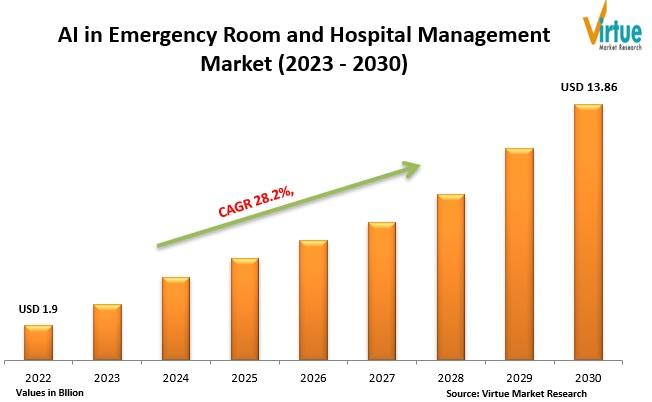AI technologies are expected to enhance the efficiency and quality of care in emergency rooms and hospitals. AI algorithms can examine patient information and medical records to help medical professionals provide faster and more accurate diagnoses. AI can also automate regular operations such as patient monitoring and drug administration, allowing healthcare workers to focus on more difficult tasks. AI can also assist in better managing patient flow and reducing wait times in medical facilities, especially emergency rooms, increasing patient satisfaction and reducing crowding. The global AI in emergency room and hospital management market is projected to reach $13.86 billion by 2030. Machine learning is predicted to experience the fastest growth in the technology segment. The hospital and healthcare providers segment is expected to see the most growth among the end-user segments in the AI in emergency room and hospital management market. North America is expected to have the greatest market expansion, followed by Asia-Pacific. There have been recent industry developments in AI, including the launch of new AI platforms and AI-powered solutions.
AI in Emergency Room and Hospital Management Market to Grow at CAGR of 28.2% and Reach $13.86 Billion by 2030

The Global AI in Emergency Room and Hospital Management Market, valued at $1.9 billion in 2022, is projected to grow at a CAGR of 28.2% to reach a market capitalization of $13.86 billion by 2030, according to a report by Virtue Market Research. The rise in AI technology is expected to be the key factor driving the growth of the market during the forecast period of 2023-2030.
The Growing Significance of AI in Emergency Room and Hospital Management
Artificial Intelligence (AI) technology has emerged as a crucial solution to improve the efficiency and quality of care in emergency rooms and hospitals. By leveraging AI algorithms to examine patient information and health records, medical professionals can provide quicker and more accurate diagnoses, leading to improved patient outcomes. In addition, AI can automate regular operations like patient monitoring and drug administration, allowing healthcare workers to focus on more complex tasks.
As the demand for healthcare services continues to grow due to the aging population and the rise in chronic illnesses, the strain on hospitals and emergency departments to deliver effective treatment is increasing. To manage patient flow and reduce wait times, AI can help by increasing the speed and accuracy of diagnoses, lowering wait times, and automating repetitive work.
One of the key market trends in AI for emergency room and hospital management is the adoption of predictive analytics. Hospitals and emergency rooms can use machine learning algorithms to analyze data and identify patterns that can predict future events, such as patient admissions or readmissions. By using predictive analytics, medical facilities can proactively manage patient flow, anticipate staffing needs, and optimize resource allocation.
Another potential business opportunity for AI in emergency rooms and hospital administration is the creation of virtual assistants and chatbots to enhance patient engagement and communication. By utilizing natural language processing and machine learning algorithms, AI-powered virtual assistants and chatbots can deliver individualized suggestions based on patient medical histories, preferences, and other data. They can answer inquiries, organize appointments, remind patients to take their medications, and provide real-time information on their treatment.
The COVID-19 pandemic has accelerated the implementation of AI in hospital and emergency department management. AI technology has played a crucial role in remote patient monitoring, resource allocation optimization, and work automation. By enabling hospitals and emergency departments to deliver high-quality treatment while reducing the risk of exposure to other patients and medical personnel, AI has become an essential tool for healthcare providers.
In conclusion, the growing significance of AI in emergency room and hospital management cannot be overstated. By leveraging AI technology, medical facilities can improve the efficiency and quality of care, manage patient flow, and reduce costs. The adoption of predictive analytics and the creation of virtual assistants and chatbots present significant business opportunities for healthcare providers. With the ongoing development of AI technology, we can expect to see continued growth and innovation in the healthcare industry.
Segmentation Analysis of the Global AI in Emergency Room and Hospital Management Market
The Global AI in Emergency Room and Hospital Management Market can be segmented based on offerings, technology, and end-user.
By Offerings, the market can be divided into software, hardware, and services. Software solutions, such as telemedicine platforms and patient monitoring systems, enable distant patient care. Hardware includes servers, storage units, and networking gear required to deploy AI in emergency departments and hospital administration. The hardware segment accounted for a majority of the revenue shares in 2022 and is expected to maintain dominance during the forecast period. Services include consulting, training, and support, which are essential for implementing and maintaining AI in hospital and emergency room administration.
By Technology, the market can be classified into Natural Language Processing (NLP), Machine Learning (ML), Computer Vision, and Context-aware Computing. Machine learning is the most established and widely used technology in the AI field, essential for creating AI-powered diagnostic tools, predictive analytics programs, and other applications that examine patient data and medical records. Machine learning is predicted to experience the fastest growth. NLP technology enables computers to understand and analyze human language. Context-aware computing technology enables computers to understand the context in which they are operating and adapt their behavior accordingly. Computer vision technology enables computers to interpret and analyze visual information.
By End-User, the market can be categorized into patients, hospitals & healthcare providers, pharmaceutical & biotechnology companies, healthcare payers, and others. The hospital and healthcare providers segment is likely to grow the most among the end-user segments in the AI in emergency room and hospital management market. This is because hospitals and healthcare providers are increasingly adopting AI-powered tools and platforms to improve patient care, optimize resource allocation, and reduce costs. Pharmaceutical and biotechnology companies segment includes companies that use AI-powered tools and platforms to develop new drugs, analyze clinical trial data, and identify potential drug targets. Government organizations, research institutions, and other organizations use AI-powered tools and platforms for healthcare-related purposes.
In conclusion, the segmentation analysis of the Global AI in Emergency Room and Hospital Management Market provides insights into the market’s key offerings, technologies, and end-users. The adoption of AI-powered tools and platforms is expected to grow across various end-user segments, driven by the need to improve patient care, optimize resource allocation, and reduce costs. The use of machine learning and NLP technologies is crucial for creating AI-powered diagnostic tools, predictive analytics programs, and other applications that examine patient data and medical records.
Regional Analysis and Latest Industry Developments in the AI in Emergency Room and Hospital Management Market
The market for AI in hospital administration and emergency rooms is expected to experience the greatest growth in North America, owing to the region’s well-established healthcare sector and the presence of prominent healthcare organizations and AI technology firms. The Asia-Pacific region is also anticipated to have significant growth due to its vast and expanding population, rising healthcare spending, and expanding use of digital technology. Europe is expected to expand at a slightly slower rate than North America and Asia-Pacific. While South America, the Middle East, and Africa are all anticipated to see growth, it will be at a slower rate than the other regions.
Several notable industry developments have taken place in recent years. In December 2021, the global healthcare technology company Cerner Corporation launched Cerner Machine Learning (CML), a new AI platform designed to help healthcare providers manage patient data and improve clinical decision-making. In October 2021, GE Healthcare announced the launch of Critical Care Suite 2.0, an AI-powered solution designed to help radiologists prioritize and analyze chest X-rays for patients with suspected pneumonia or pneumothorax. In September 2021, Olive, a healthcare technology company, announced that it had raised $400 million in a funding round led by Vista Equity Partners. The company provides AI-powered solutions to healthcare providers to help automate administrative tasks and optimize workflows.
Virtue Market Research is a strategic management firm that helps companies tackle their strategic issues and make informed decisions for their future growth. They offer syndicated reports and consulting services designed to provide insights into the constant flux in the global demand-supply gap of markets.
In conclusion, the regional analysis and latest industry developments in the AI in emergency room and hospital management market highlight the growth potential of the market in North America, Asia-Pacific, and Europe, as well as the notable developments in the healthcare technology sector. The increasing adoption of AI-powered solutions in healthcare is expected to drive growth and improve patient care, workflow optimization, and cost reduction.
Don’t miss interesting posts on Famousbio










